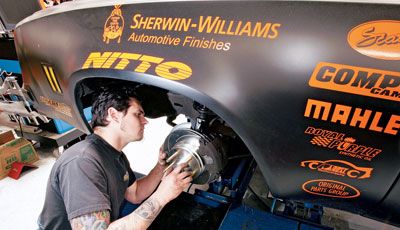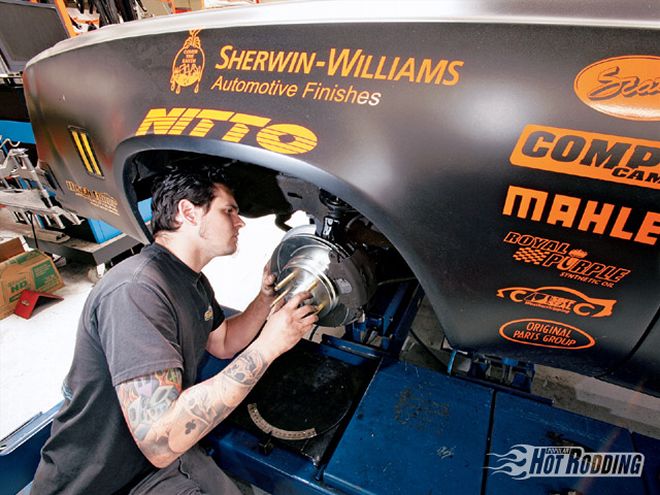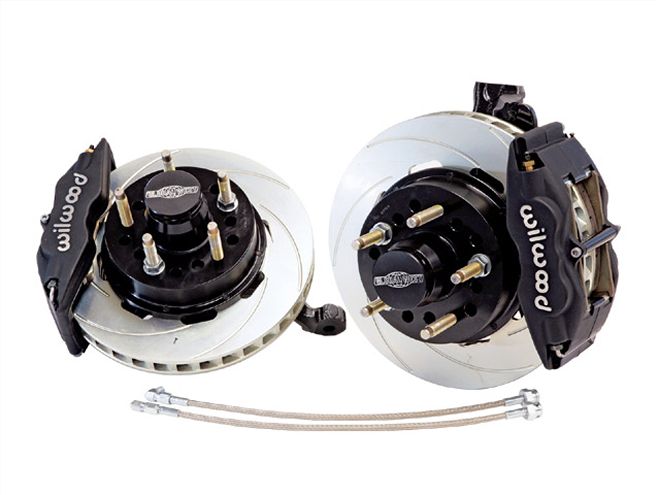

From the beginning, Project Talladega has stuck doggedly to a NASCAR aesthetic. Right or wrong, we feel the stock car racing theme is the most fitting one for a '75 Laguna, since that is primarily how history will remember that marque. So far, we've successfully pulled off the bodywork, paint, graphics, wheels, tires, and unique NASCAR-inspired exterior pieces, but only recently started on the serious performance pieces. Early on, we discovered that the suspension experts at Global West specialize in chassis bolt-ons for '73-77 GM Colonnade A-bodies like our Laguna. Since one of the eventual goals for Project Talladega is to do some road course and autocross work, we had to avail ourselves of Global West's full line of bolt-on suspension parts, which we detailed in our June and July issues.
At that point, we found ourselves in somewhat of a bind. By sticking with the NASCAR look and the attendant 15-inch steel wheels, we discovered the primary shortcoming of the vintage stock car vibe: small brakes. At this point it's worth noting that from the beginning, the sole purpose of the Pro Touring movement and the big-wheel look was to fit larger, more capable brakes. Everything else-including the styling-came from that initial need. You can therefore see the irony of our current situation. We are, in essence, creating a Pro Touring car, without the Pro Touring look.
 Global West offers a disc brake package called Cat 5, which we originally thought would fit our 15-inch Bassett steel wheel. The Cat 5 system has a special two-piece 11.75-inch rotor with a custom billet hub; calipers are four-piston Wilwoods. The offset on the hub is designed so that a 1 1/4-inch-wide stock car rotor can be used while keeping the load on the spindle in the correct place; these are widely used in stock car classes where a stock 15-inch wheel is required.
Global West offers a disc brake package called Cat 5, which we originally thought would fit our 15-inch Bassett steel wheel. The Cat 5 system has a special two-piece 11.75-inch rotor with a custom billet hub; calipers are four-piston Wilwoods. The offset on the hub is designed so that a 1 1/4-inch-wide stock car rotor can be used while keeping the load on the spindle in the correct place; these are widely used in stock car classes where a stock 15-inch wheel is required.
At first, we investigated all the midrange-priced brake systems with 13-inch rotors and dual pistons-the center mass of the Pro Touring bolt-on market. That was a losing proposition, as the calipers would tag the drop center of the steel wheel every time. No problem, we'll just step down to an entry-level 12-inch system with smaller dual-piston calipers. Amazingly, nothing in an entry-level system would clear the drop center of our Bassett steelies either. What we discovered is that the Bassett wheel we chose has an even deeper drop center than the stock 15-inch steel wheel. We hit the max level of frustration after trying out a very trick Cat 5 system from Global West that uses a slim dual-piston Wilwood caliper on a beefy two-piece 11.75-inch rotor bolted to a custom aluminum hub. These brakes were especially designed for use in racing series that require 15-inch steel wheels. In spite of this system's wide-spread use in stock car racing (and with different types of 15-inch steel wheels), they still hit the drop center of the Bassett D-Hole Lightweight design. Do not pass go, do not install cool brakes. Bummer.
Back at square one, we knew at least one brake system that fit: the stock system. It turns out that Global West offers a front brake system for our Laguna that uses a stock caliper from a '70-73 Camaro. (This is also the same caliper that's on our Laguna.) While not the optimal situation, the single-piston Camaro caliper does get a boost in the leverage department from Global West's larger 12-inch gas-slotted 1LE rotor. (The stock rotor is 11.75 inches.) In order to use the larger rotor, Global West mounts the rotor and caliper on a new spindle with a longer caliper mounting ear. The best part is that the whole thing fits inside our Bassett steelies.
Packaged as part number DB1812, the Global West brake system comes pre-assembled with new 12-inch zinc-washed and gas-slotted 1LE rotors, new (not reman) single-piston '70-73 Camaro calipers, new spindles, bearings (packed), seals, dust plates, Wagner brake pads, and new braided stainless steel hoses. The price of $1,208 for the kit is inclusive, but depending on the customer need, can be customized. We decided to use our original calipers and brake lines, which got us off the hook for filling and bleeding the system. This also saved us $230. For an extra $20, we upgraded to long 1/2-inch -20 ARP wheel studs to complement the NASCAR theme (7/16-inch -20 studs are standard). To pull off that look, we also needed the big NASCAR lug nuts, which we got from Bassett for $1.45 each.
In the end, however, it's stopping power that's in short supply with the limited real estate of a 15-inch wheel. Without the resource of bigger, better calipers, we turned to the brake pad itself for improved performance. And while the stock-style Wagner PD52 pads included with the Global West kit are fine for regular driving, we turned to EBC for a set of Yellowstuff pads in their DM1793 compound.
Based in the United Kingdom, EBC specializes in the high-performance street and race market. It turns out, they make a huge array of products for classic muscle cars. Part of EBC's strategy is a simple marketing plan: color code the product to the use. With this, there is no ambiguity as to the proper intention of the pad in question. In the case of EBC's Yellowstuff pad, an aramid-fiber-based compound with a high brake effect (that starts from cold, and gets stronger with heat) makes it ideal for high-performance street and track use. EBC says Yellowstuff pads are not low-dust, luxury-car pads like their Redstuff line, but like street pads, they do build up heat quickly. (Race pads tend to need lots of use to build up the necessary friction.) EBC Yellowstuff pads are produced in two compounds, DM1846 and DM1793. For more street-oriented cars that will see track use like our Laguna, EBC recommends the DM1793 compound, which is the running favorite in the Swedish Camaro Cup series.
Will larger 1LE rotors and better EBC pads be able to handle track use on a 4,000-pound coupe? We'll find out soon enough. We've just finished dropping in the new T&L 408ci solid-roller small-block and backed that up with a Phoenix Transmissions 700-R4 overdrive and converter. With a custom double-hump trans crossmember from LP Racecars and a side-exit NASCAR-style exhaust from Dr. Gas, we're back on the road again for some shakedown miles. Once the bugs are worked out, we'll finally be able to put all those Global West suspension and brake parts through some instrumented testing. Now you think they'll let us through the gate at Talladega?
WHERE THE MONEY WENT Description: Source: Part No.: Price: 12-inch front brakes Global West DB1812 $1,208 Reuse existing calipers-credit Global West n/a -$230 Upgrade to 1/2-inch -20 studs ARP {{{100}}}-7704 $20 Yellowstuff brake pads EBC/{{{Summit}}} DP41145R $105.95 NASCAR lug nuts, 1/2-inch -20 Bassett Racing n/a $1.45 ea. Total: $1,118.45 PROJECT TALLADEGA THE COST SO FAR Description: PHR Issue: Cost: '75 Chevy Laguna Oct. 2008 $5,000.00 Phoenix 700-R4 trans and converter* Feb. 2009 $2,800.00 Sherwin Williams paint, materials, and labor Mar. 2009 $3,979.73 Makeover (tires, wheels, graphics, seats, etc.) Apr. 2009 $2,989.95 T&L 408ci solid-roller small-block* May 2009 $7,685.00 Global West rear suspension June 2009 $1,699.36 Global West front suspension July 2009 $2,569.83 Global West front brake upgrade Sept. 2009 $1,118.45 Total: $27,842.32 *installed—to be shown in future issue